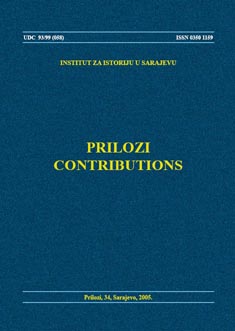Prilog Historiji Svakodnevnice: Spomenik Umorstvu - Okamenjena Prošlost na Izdržavanju Stoljetne Kazne
Contribution of Everyday History: Memorial To Murder – The Stone Monument That Suffered A Century-Long Sentence
Author(s): Indira Kučuk-SorgučSubject(s): History
Published by: Institut za istoriju
Keywords: Sarajevo Assassination; memorial; Franz Ferdinand; Sophie Höchenberg
Summary/Abstract: The memorial to the victims of the assassination, Ferdinand and Sophie, was a grandiose work of sculpture entitled “Memorial to Murder,” which was designed and made by sculptor Eugen Bory from Hungary. On June 28, 1917, the third anniversary of the Sarajevo Assassination, the monument was mounted across the street from the site of the assassination, on the edge of the Latin bridge. The memorial had three parts: two large columns of about ten meters high and central medallion engraved with the faces of Franz Ferdinand and Sophie, in front of which lay a space to put flowers and light candles. The memorial was around twelve meters high. It remained on the same spot until the end of 1918 when the new south Slav state, the Kingdom of Serbs, Croats, and Slovenes, removed it and started an odyssey of the monument. It was kept in the Zemaljski Museum, where it remained until the end of the Second World War when it was transferred to the jurisdiction of the Institute for the Protection of Monuments. In the meantime, the Art Gallery of Bosnia and Herzegovina was founded, so the monument was placed in its warehouse where it remained for more than forty years. However, the Gallery did not have the entire monument; it only had the central part – the medallion with the faces of the archduke and his wife. Where the rest of the monument was kept during the “interregnum” is unclear. One of the two columns ended up with a sculptor in Trebinje, and the other with a stonecutter in Sarajevo on Kobilja Glava.
Journal: Prilozi
- Issue Year: 2005
- Issue No: 34
- Page Range: 61-66
- Page Count: 6
- Language: Bosnian

